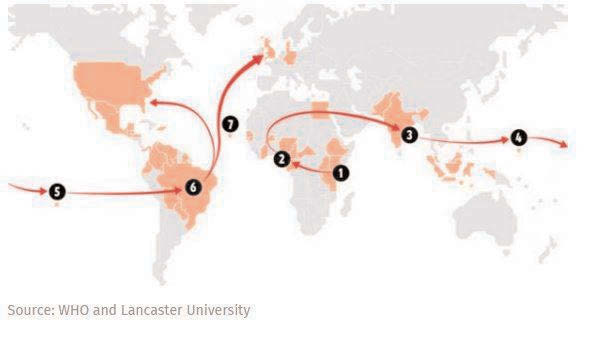
NIGERIA (TIP): The World Health Organisation has called an emergency meeting to address the spread of the mysterious Zika virus, as health experts warned the outbreak is ballooning at an “extremely alarming” rate.
The disease has been linked with a birth defect known as microcephaly, which sees children born with abnormally small brains, as well as a neurological syndrome that can cause paralysis.
Margaret Chan, the director-general of the WHO, said board members would meet on Monday 1 February to establish if the Zika virus should be declared an international emergency.
And an official at the organisation’s office for the Americas, where the disease has spread to 23 countries in a matter of months, said we can “expect three to four million cases”.
HOW THE DISEASE SPREAD
Though it is possible the Zika virus originates in South East Asia, it was first documented in Uganda in 1947 (marked by (1) in the map above) in the antibodies of local people, meaning they had been exposed to it in the past.
It spread throughout Africa, with the first live case recorded in a human patient in Nigeria a decade later around 1960 (2). The outbreak only threw up around a dozen confirmed cases.
In 1966, the first case was confirmed in South East Asia, and in the late 1970s it was documented in Pakistan, India, Malaysia and Indonesia (3).
The first official epidemic was on the isolated island of Yap, Micronesia, in 2007 (4). It affected almost 200 members of the island’s small population, making it a relatively major crisis.
It hit French Polynesia in 2013, with a huge outbreak of 35,000 cases (5). Some led to instances of Guillain-Barre syndrome and paralysis, while recent retrospective research suggests there was also a corresponding spike in microcephaly.
In 2014, around the time of the football World Cup, Zika arrived in northern Brazil (6). Some suggest it could have been brought over during the World Canoeing Championships in Rio around the same time, an event which involved a large number of Pacific Islanders.
It spread slowly through Brazil for around a year, before the WHO reported the first outbreak outside the country – Colombia – on 21 October 2015.
Other countries then followed quickly, with transmission reported in Suriname, El Salvador, and Guatemala by the end of November.
In early December, the disease spread to Mexico for the first time, raising concerns in the US, as well as to Paraguay, Venezuela and Panama.
By the start of January, Honduras, Puerto Rico, French Guyana and Martinique in the Caribbean had cases.
And in the past week or so, cases have been confirmed in Guyana, Barbados, Ecuador, Bolivia, Haiti and the Dominican Republic.
A handful of isolated cases have been reported locally in the US, the UK, Denmark and now Germany (7) -though experts stress these are all travel-related and full outbreaks in these countries are unlikely.
And meanwhile, there have been several thousand cases of Zika reported in Cape Verde of West Africa since September. It is not known for certain whether these were imported there from mainland Africa or from fellow Portuguese-speaking Brazil. If the latter is the case, the disease has circumnavigated the globe – and could legitimately be described as a pandemic.
WHY IS IT ONLY ‘ALARMING’ NOW?
In most patients, the Zika virus has relatively minor flu-like symptoms which subside without much incident in no more than a week. It has a lower mortality rate than winter flu, and seems limited to equatorial areas with high numbers of the Aedes biting mosquito.
Yet the unprecedented Brazil outbreak which began in 2014 has corresponded with a sudden spike in cases of microcephaly – 3,893 cases as of last week, more than 30 times greater than any other period since 2010.
Speaking to The Independent, University of Lancaster lecturer and virologist Dr Derek Gatherer said we know so little about the virus largely because its normal symptoms are so mild.
“We don’t even know exactly what time during pregnancy women are most at risk, beyond knowing what time the brain develops,” he said. “The effects could even come from before conception – that’s why we have to be so cautious with advice.”
The WHO says that while a direct causal relationship between the Zika virus and more serious complications has not been confirmed, it is “strongly suspected”.
“The possible links, only recently suspected, have rapidly changed the risk profile of Zika from a mild threat to one of alarming proportions,” she said.
WILL IT SPREAD TO THE UK, US OR REST OF EUROPE?
In theory, the WHO has warned that the virus has the potential to spread over the entire of the Americas with the exception of Canada.
Isolated cases related to travel to and from Latin America have been reported in the US, Britain, Denmark and Germany.
Dr Gatherer said that the Aedes mosquito, which carries the disease, occurs in southern Europe from Spain to France, Italy and Greece, and outbreaks there are possible.
But these would likely be limited in the number of transmissions, and the disease almost certainly won’t spread in more temperate climes like the UK where the Aedes mosquito doesn’t live.
“There’s a real North-South divide here between poor and rich countries,” he said. “The disease has been in Mexico since the start of December but it seems to have stopped at the American border, almost as if it hasn’t been allowed across.
(AP)





Be the first to comment